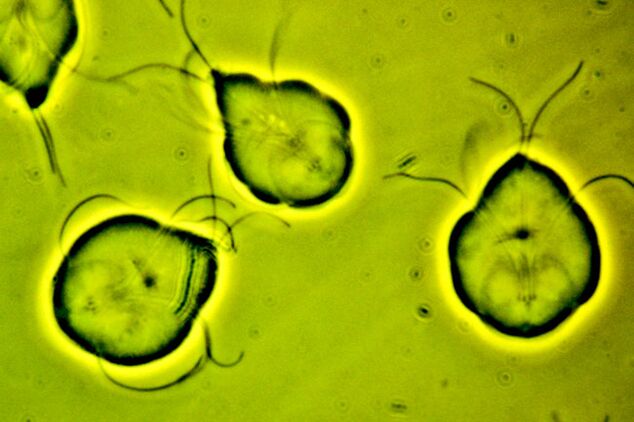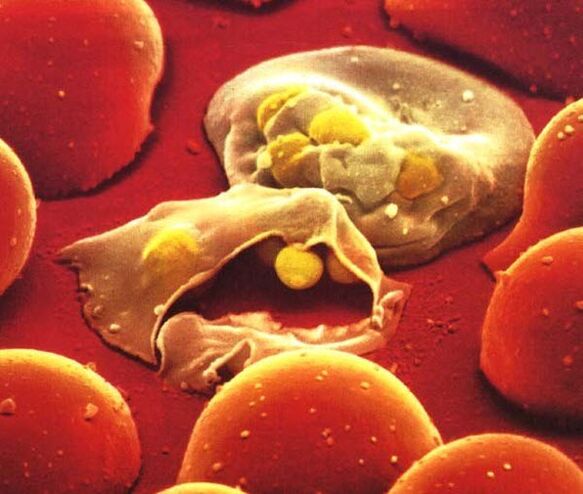When it comes to parasites in the body, most people think of worms in the intestines. However, other parasites are also very common, they are difficult to diagnose and affect other organs, not the intestine.
These are the simplest microstructures (the most common are parasites) and may not appear in any way for a long time. However, the simplest parasites can also cause major damage to the body.
Giardia
Giardia is a tiny flagella parasite with two nuclei and two sets of organelles.

Human giardiasis is caused by the most common type of parasite-the intestinal Langeriana. In addition to humans, other mammals and birds can also infect them. Parasites can form cysts in localized organs.
Giardia is found in untreated tap water and natural sources-spring water and wells. They are found in the meat of infected animals or birds, a small amount are found in the feces of infected animals, and sometimes they live in the soil, so they are found in vegetables and berries.
Usually, the infection occurs through the fecal-oral route, that is, for the development of the invasion, a large number of parasite cysts must be swallowed. Usually, children and adults as young as three months old will get sick.
In most cases, the disease is asymptomatic, and the patient learns about it accidentally. But sometimes there are some symptoms (continuous or intermittent). The gastrointestinal symptoms are as follows:
- stomach ache;
- Abdominal distension
- Nausea, sometimes vomiting;
- Rumbling in the belly;
- Constipation and diarrhea alternate;
- Biliary dyskinesia;
- Skin allergies;
- General weakness.
Like intracellular parasites, Langerial parasites are mainly treated with metronidazole. However, in the first stage of treatment, it is necessary to eliminate the poisoning and normalize the work of the bile ducts. Only after this is antiparasitic treatment. After that, treatments aimed at restoring the body's defenses and improving immunity are performed.
amoeba
Amoeba is the simplest human parasite and can cause amebic dysentery or amebiasis.
There are also various amoeba that can affect the eyes. Causes amoebic encephalitis, but it is less common. According to the World Health Organization, this type of invasion is not the most common, as only 10% of people are infected with it (and for Giardiasis, according to some sources, this number is 50%).
The amoeba is transmitted entirely through the fecal-oral route, that is, as in the previous case, the cysts formed by the amoeba must be swallowed for infection to occur.
Countries with hot climates and poor sanitation are more likely to be infected. Cysts can maintain the infection ability for a long time in soil, water, vegetables and berries grown on contaminated soil. Cockroaches and flies carry these cysts to some extent.
Like intracellular parasites, amoeba will only show symptoms 7-10 days after infection. Symptoms of colitis: abdominal pain (in the lower part), general weakness, slightly elevated body temperature. In most cases, the liver will be affected because the organs will grow and thicken after two to three weeks of pain.
Arcuate
Toxoplasmosis is a disease that causes toxoplasma gondii. This is the simplest creature, mainly distributed by representatives of the cat family as its carriers. Infected people can also spread it.
It is spread through the fecal-oral route. You can become infected by eating poorly processed meat and eggs from infected animals and birds. To a lesser extent, it can still be transmitted through the blood, in the case of wounds (for example, when handling contaminated soil in the garden), and in contact with mucous membranes.
It is mostly asymptomatic, and like many viruses, it was accidentally diagnosed in an enzyme-linked immunosorbent test. In the acute form, healing usually occurs independently. Pregnant women need to be treated with pyrimethamine drugs (used to treat intracellular parasites).
Plasmodium
Plasmodium is an intracellular parasite that causes malaria. Five types of pathogens can be parasitic in humans. In addition, they are located in the blood, on their cell membranes.
The disease is spread through blood (for example, through blood transfusions). Certain types of mosquitoes can also tolerate it when biting, because mosquitoes are the intermediate host of malaria parasites. As a result, the person contracted malaria.
These mosquitoes (and corresponding diseases) are common in hot countries, mainly in Africa.
Malaria has severe symptoms that start to appear 5-7 days after infection. The first symptoms are joint pain, fever, and severe chills. Then headache and splenomegaly.

Treatment is carried out with quinine preparations under the strict supervision of a doctor.
Trichomonas
These are the simplest human parasites that cause trichomoniasis. Affect the human genitourinary system. It is the most common sexually transmitted disease and the most common disease of the genitourinary system.
Spread only through sexual contact. In women, they live in the vagina, and in men there are Trichomonas-in the urethra, seminal vesicles, and prostate.
In women, the symptoms are as follows: vaginal discharge, genital skin itching and flushing, pain during urination and sexual intercourse, and inflammation of the vaginal mucosa. Male: urethral discharge (rarely, bloody), pain during urination, prostatitis symptoms with prostate damage.

It is necessary to treat the diseases of both parties. It is treated strictly with anti-trichomoniasis drugs alone under the supervision of a doctor. In some cases, immunization or symptomatic treatment is required.

























